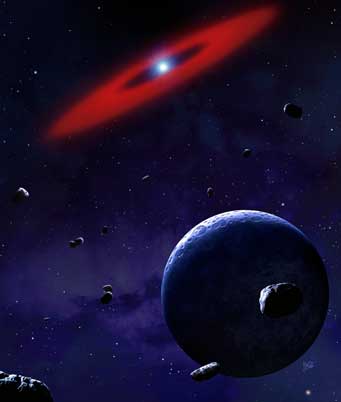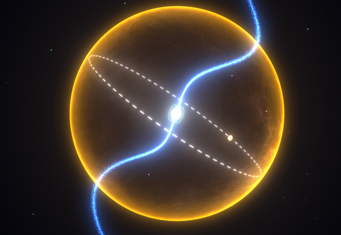Forget finding Earth 2.0. Some astronomers aim for more exotic fare, searching for exoplanets around white dwarfs and pulsars.
In roughly 5 billion years, our normal, yellow Sun will puff up into a red giant. Our star will engulf the orbits of some of the inner, rocky planets (whether Earth will survive or not is debated) and lose half its mass in winds before it collapses into a white dwarf remnant even smaller than Earth. Even the outer planets won’t be safe — the Sun’s mass loss could send previously stable planets into wild orbits, perhaps careening into the Kuiper Belt on long, elliptical paths. The prospects for life’s survival after all of that are not great, but let’s say we endured. (Maybe humanity camped out on Saturn’s moon, Titan.) What would we see?
White Dwarfs, Planets, and Asteroids

This artist's illustration shows the dusty disk surrounding the white dwarf SDSS1228+1040. Astronomers think this disk was created from the debris of a disrupted asteroid.
Mark A. Garlick
Finding planetary systems around white dwarfs isn’t easy. Astronomers can’t use the usual planet-hunting methods: white dwarfs are too dim for current telescopes to catch the dip caused by a transiting planet.
Instead, astronomers have to look at the white dwarfs themselves. When a white dwarf forms, it pulls all heavier elements inside its core, leaving an atmosphere of pure hydrogen and helium. Yet heavy elements “pollute” at least a quarter of white dwarf atmospheres. The only way for those elements to get there is if they’re accreted after the white dwarf has already formed. And that requires planets.
A gravitational bump from a planet can send smaller objects, such as asteroids, hurtling inward. When they pass too close to the white dwarf, they shred into dust particles, coalesce into a disk around the stellar remnant, and eventually accrete onto its surface.
Sometimes that disk is visible, and in these cases the connection between pollution and perturbed asteroids is clear-cut. But the disk is only visible in 1% of white dwarfs, and without a disk, the connection between pollution and planets is less clear.
So John Debes (Space Telescope Science Institute) organized a spectroscopic survey of polluted white dwarfs using the Magellan telescope at Las Campanas in Chile. Based on the statistical analysis of 30 white dwarfs, he found that the polluting material has to come from a disk around the stellar cinder. The disk circles the white dwarf tightly enough that all of it lies within the tidal disruption radius, which suggests shredded asteroids are the disk’s source material. Debes’ observations make a connection between pollution and planets in all cases, not just when the disk is visible.
Ben Zuckerman (University of California, Los Angeles) used Keck to find polluted (and therefore likely planet-hosting) white dwarfs in the rich Hyades star cluster in Taurus. Such tightly packed environs are not ideal for planet formation because the close passage of other stars might disrupt planetary systems. Nevertheless, one of the 10 targets (named LP 475-242) showed the pollution Zuckerman was looking for, suggesting the presence of planets. This is the first potential planetary system found in the Hyades cluster.
“I think it’s amazing that we’re seeing planets surviving stellar evolution to show up as planetary systems around these dead stars,” Debes said about Zuckerman’s work. Zuckerman and Debes presented their work yesterday at the American Astronomical Society meeting in Long Beach, California.
Pulsar Planets

Artist's impression of the "diamond" planet orbiting the pulsar. Scientists think the planet was the pulsar's companion white dwarf, until it was stripped down to its core.
Swinburne Astronomy Productions
White dwarfs aren’t the only stellar cinders to host planets. Pulsars, the spinning compact cores remaining after massive stars explode, host planets too. Pulsar jets act like searchlights from a lighthouse, passing our way at what should be very regular intervals; if the pulses are timed accurately enough, tiny irregularities can reveal the presence of Earth-size planets, and even moon-size objects. Some of these objects survived the stellar explosion, but in other systems, the planets might have formed afterward out of the explosion debris.
Only three pulsar planetary systems have been found so far, and every one has broken a record. The first confirmed exoplanets were found orbiting pulsar PSR B1257+12 in Virgo. The first circumbinary planet was found circling a pulsar and a white dwarf. And last year, in the strangest case of all, pulsar PSR J1719-1438 was found hosting a “diamond” planet, which turned out to be a white dwarf star stripped of its outer layers until it weighed as little as Jupiter.
While Kepler stays busy announcing thousands of planet candidates, one might wonder why only three planetary systems have been found around pulsars. Aleksander Wolszczan (Penn State University) explains that’s probably because astronomers haven’t been looking in the right way. It requires very sensitive measurements made very frequently by large telescopes, a combination difficult to achieve in practice.
 1
1
Comments
Robert L. Oldershaw
January 13, 2013 at 4:12 pm
In 1989 the self-similar cosmological paradigm (aka Discrete Scale Relativity in the case of exact cosmological self-similarity) predicted pulsar-planet systems.
No other theory made this prediction, and conventional astrophysics is still unable to give a convincing explanation of how these systems form.
The first pulsar-planet system was discovered in 1994, and subsequently at least 3 more have been found.
[See discussion at http://www3.amherst.edu/~rloldershaw/SP3NU.HTM ] .
Robert L. Oldershaw
Discrete Scale Relativity
Fractal Cosmology
You must be logged in to post a comment.
You must be logged in to post a comment.